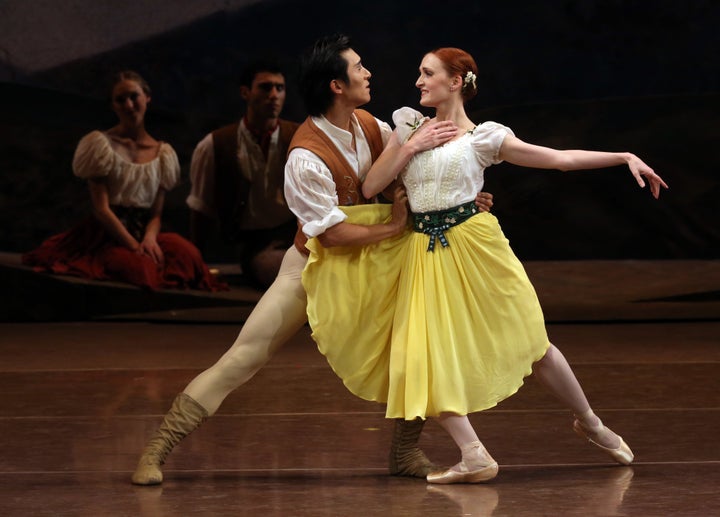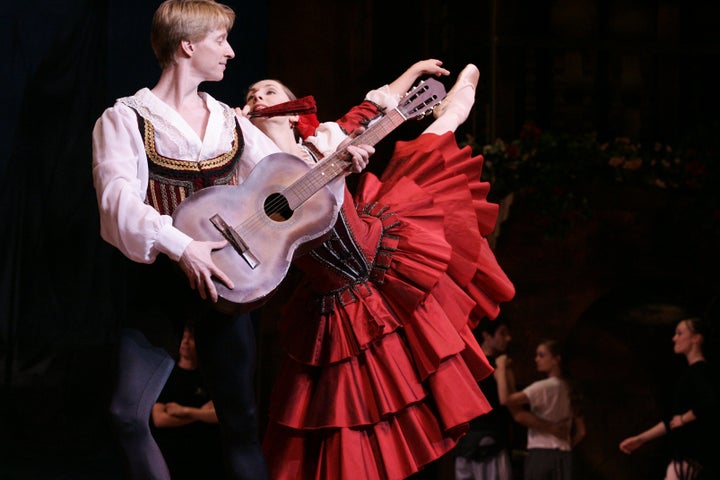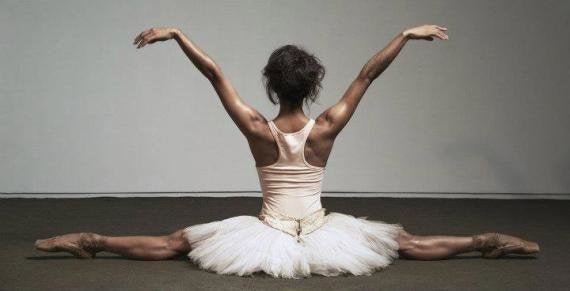
In this series, The Huffington Post profiles some of the best ballet dancers in the world, working in some of the rarest and most unusual work environments imaginable, to try to understand how they deal with the same workplace issues that confront the rest of us mere mortals.
Most of us don’t get literal standing ovations from hundreds of people when we do good work. And most of us don’t have to visit the physical therapist at the beginning and end of every workday. But no matter what sector we’re in, the big questions are the same: What does it mean to have your body under scrutiny on the job? How does it feel to be asked to represent your entire race in a company meeting? How do you find the right people to mentor and guide you?
Read the first installment, about being the kind of partner people fight to work with, and the second, about changing careers.

If you’ve ever wondered what it’s like to fall hard for a colleague, or work alongside your significant other, Gillian Murphy can tell you. She can also tell you what it’s like to stand in the background and work your ass off while your partner kisses someone who is not you in front of a large crowd and gets paid for the privilege.
Murphy is a Principal dancer at American Ballet Theatre, where she’s spent almost 20 years honing her craft and becoming one of the nation’s greatest working ballerinas. She’s also spent much of that time falling in love and building a life with a co-worker.
Murphy joined ABT at 17, entering the company’s lowest rung, the corps de ballet. Two years later, she started dating Ethan Stiefel, a principal dancer and company star who was six years her senior. While she was dancing in the corps, he had already been a principal at New York City Ballet and toured the world as a guest artist at other prestigious companies. They had their first kiss on her 19 birthday.
“We connected on a human level outside of work,” she told The Huffington Post, munching spinach salad and sipping on juice as she recovered from hours of rehearsal. Stiefel, who some readers might recognize from his turn as ballet bad boy Cooper Nielson in the "Center Stage" movies, retired from dancing five years ago and would go on to become Artistic Director of the Royal New Zealand Ballet. But for years, they worked together, taking daily morning class and often rehearsing and performing romantic ballets like "Swan Lake" and "Don Quixote" together.
It’s not uncommon for dancers to date and marry each other. A dancer’s work life is so consuming that it can make it hard to find the time to meet people outside of the dance world. Murphy’s fellow principal dancer, Stella Abrera, is also married to a dancer who was in "Center Stage" -- Sascha Radetsky, aka Charlie, and who, like Stiefel, now teaches in ABT's master’s dance pedagogy program.
The company doesn’t frown on dancers dating, or advise them against inter-rank dating -- principal dancers don’t have any influence over casting or promotions the way ballet masters/mistresses, choreographers and directors do. Murphy says that, in the early days, dating Stiefel came with challenges, though. There was the age difference, and the fact that he was much further along in his career. And then there was the jealousy she felt when she had to watch him play at falling in love with other women night after night -- to say nothing of the intimacy and trust required for him to lift and throw those women around in pas de deux.
“He was doing 'Romeo and Juliet' with gorgeous leading ballerinas in the company, and other romantic ballets that involve a lot of chemistry and kissing and love portrayed on the stage,” she says. “So as a 19- and 20-year-old that made me a little uncomfortable. Because he was playing Romeo alongside some of my idols.”

As she advanced in her career, though, and started dancing solo roles, Murphy saw for herself that, while what happens on stage is real, it’s not true. It's just acting. She learned first hand that creating the illusion of earth-shattering love “is part of the job, you have to create chemistry on stage and it doesn’t need to be anything to be worried about in real life ... you can fully connect with someone on stage, but that doesn’t even compare to who you want to spend your life with, your evenings.” She learned, she says, to support Stiefel in his dancing and to stop being intimidated when he was on stage pretend-making out with the Black Swan.
Murphy was promoted to soloist a year after she and Stiefel started dating, and to principal three years after that. At 36, she’s been a principal for 13 years and is the most senior dancer in the entire company. Now that Stiefel’s retired, he teaches company class once a week, so their working relationship has changed yet again. Is it weird being a student in her husband’s class? “No, it’s great,” she laughs. “He teaches a great class. I love him, and I love his artistry, and what he’s passing on.”
In the ballet world, there are real upsides to dating a co-worker. For one thing, they truly understand what your work life is like; they literally speak the language, the French-English hybrid that so many ballet dancers rely on to talk about their work. For another, Murphy points out, touring with the company has meant that she and her now-husband were able to travel the world together and be paid for the pleasure.
On the other hand, when you live together and work together, it can be hard to find time apart.
And not all dance couples work quite so well. It’s easy to imagine that the higher-ranked dancer in a romantic relationship might want to keep that power dynamic intact, and would begrudge or belittle their partner’s advance through the ranks. Murphy says that’s never been the case for her. “I couldn’t be in a relationship like that. That would be awful. Ethan was always genuinely rooting for me, and I think he was genuinely aware to not influence me in terms of my career choices, and to let me learn on my own. But if I needed help he was there.”
They’ve managed to keep competition out of their relationship, and, it seems -- somewhat paradoxically -- they manage to keep ballet out of it, too. “In some dance-life partnerships people like to give each other corrections all the time and constantly give each other that technical ballet feedback about what worked and what didn’t,” she says, frowning. “And we’ve just never done that.”
If it’s common for dancers to date and marry, it’s common for them to break up, too, and just as in other workplaces, they’ve still got jobs to do. This is, it’s worth noting, exactly what happens to Ethan Stiefel’s character in "Center Stage."
Much of Murphy’s life at ABT has been lived as part of a ballet duo-turned-power couple. But on the day she speaks to HuffPost, she’s dancing on her own. Her regular work day starts with a morning company class, and then she moves from one rehearsal to the next, learning or perfecting the choreography she’ll be performing in the next few months. At a half-hour private rehearsal in the mid-afternoon, it’s just her, a ballet master -- Keith Roberts, himself a former ABT Principal -- and an accompanist. She arrives wearing a black mesh-back leotard and black-and-white patterned tights. Roberts helps fasten the back of her rehearsal tutu, so that she can know how the steps will feel once she’s got a large and obtrusive skirt bouncing around her hips. In this rehearsal, she’s calling the shots. There’s no set agenda, but she tells the men she wants to rehearse her solos for "Sleeping Beauty."
She starts with the third act solo, which begins with a series of 11 huge développés -- big left lifts with her supporting leg on pointe -- that bring her from the back of the stage right down to the front and then moves on to a series of enormously difficult pirouettes that she has to land in a perfectly still arabesque. After a couple of run-throughs, Roberts tells her it’s looking good and she nods, wide-eyed, like she’s not so sure. She moves on to the next solo, which includes a long sequence of delicate footwork done entirely on pointe.
Part way through, the pianist struggles with a sticky key, and the music slows. Murphy, who’s spent three decades listening to music and arranging her body accordingly, slows down while he catches up, and laughingly asks, mid-arabesque, “You OK, Ben?” The variation ends with a series of terrifyingly fast turns that take her from one side of the studio to the other. Then she launches into yet another solo, her pointe shoes squeaking on the rubbery floor in a way that audiences will never hear over the sound of the orchestra. That one ends with her leaping around the stage in a huge circle, her legs splitting to 180 degrees in each of the eight or so jumps. “This kills my calves,” she says when the music stops. “I’m sure it’s impossible, but it looks great,” Roberts replies.
Soon, she’ll start rehearsing with a partner. She’ll perform this ballet with fellow principal Cory Stearns, and "Sylvia" with Marcelo Gomes. But at the end of the day, she’ll go home to Stiefel. After almost two decades in the company, the partnerships Murphy has built with the men she dances with are crucial -- you can’t dance together without trust and chemistry -- but what she has with her dance partners is distinct from what she has with her life partner. “When I’m on stage portraying Juliet, I’m very much in the moment, and I feel that chemistry with my partner and I can have that moment, but when the curtain comes down, I’m fully myself again.”
American Ballet Theater will perform at the Detroit Opera House starting March 31 and at the Metropolitan Opera Theater in New York City starting May 9.

